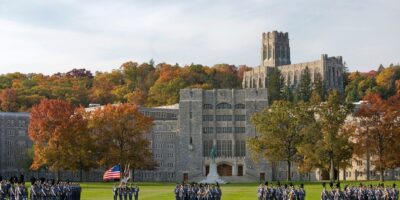The Climate Collapse Thesis

In 2003, someone leaked a “secret” Pentagon report warning of the dire consequences of climate change.
“Disruption and conflict will be endemic features of life,” it reads. “Once again, warfare would define human life.”
The report’s authors offer dramatic examples, including the claim that “catastrophic” shortages of potable water and energy would lead to widespread war by 2020. Britain would have winters similar to those in Siberia as European temperatures drop off radically by 2020.
In 2017, there was a war in Yemen. But it wasn’t all that widespread. And Yemenis experienced water shortages, but not war due to a shortage of water.
Britain underwent milder winters in 2015, and there were slightly colder winters in the five years prior.
So 2020 came and went.
Of course, a credulous press, eager to propagate the dire warnings, had been happy to report what turned out to be false predictions. In other words, we never did get catastrophic water shortages and permafrost in Britain. How could the authors have gotten things so wrong?
To give you a better idea, let’s zoom out.
Imagine we’re in a low intellectual orbit, high enough to get a wide shot but low enough to see some things. From this macro perspective, we want to evaluate a set of claims about climate change that we must connect to form a coherent theory. Let’s take some familiar premises from what we might term the Climate Collapse Thesis and view them in their totality.
To accept the Climate Collapse Thesis – that climate change ought to be seen as the number one potential driver of catastrophe – we have to accept all of the following hypotheses:
- The earth’s atmosphere and oceans are warming.
- The earth is warming primarily due to emissions like carbon dioxide and methane, generated by people engaging in production, trade, transportation, and energy use.
- Scientists can limn the most important phenomena associated with a warming climate, and disentangle human causes from natural ones, extending into the distant past.
- The data gathered and then aggregated by the scientists are overwhelmingly error-free, and the scientists operate free of biases when packaging and presenting their data. (This special group of scientists suffers neither from a peer-review nor a replication crisis, and they are immune to the perverse incentives of government funding.)
- Even though individual scientists are working separately on different aspects of climatology and related fields, they can stitch these diverse aspects together into one complementary dataset, supporting a single, coherent hypothesis up to this point.
- Scientists can then use computer models to simulate most of the phenomena associated with the earth’s warming and make reasonable predictions, within a degree or two, about a hundred years into the future.
- A different group of scientists can repackage that packaged information and make certain predictions about the dangers that a couple of degrees of predicted warming will make over that hundred years, say to glaciers, farmland, and sea levels.
- Social scientists, including economists, can then repackage – without loss of accuracy or the introduction of error – the aforementioned global predictions and make yet further predictions about the costs (and benefits) accompanying those predictions. Of course, the relevant subset of these portends either ecosystem collapse, social collapse, or both (and that subset is appropriate to the Climate Collapse Thesis in this context).
- Based on what the world might be like if that different group of scientists and the social scientists turn out to be correct, policy wonks can, in turn, accurately predict what the world will be like if specific climate policies are implemented. And these policies minimize those effects the social scientists predicted.
- Policymakers can then take the prior groups’ predictions and set policies that will mitigate the predicted warming (and subsequent collapse). Such will ensure that what’s best for the people and planet – on net – is balanced against other important considerations.
- The policies, once imposed, will be implemented such that they work as intended. And all major emitting nations must cooperate close to global unanimity. That means there should be no defections, corruption, or false reporting by such trustworthy authorities as China’s Communist Party.
- Abatement of greenhouse gas output has a real effect on the rate of climatic change, enough to pull the world out of danger, including climate collapse.
- Those policies are worth the costs they impose on the world’s people, especially the poorest.
I repeat: to accept the Climate Collapse Thesis, we have to accept everything above.
Yet the interdependencies are staggering. It’s not just possible but probable that any one of these linkages will break. A humbler interpretation of climate change science and policy, far from being a conspiracy of denialists, turns out to be an imperative of reason.
Let’s assume the Climate Collapse Thesis is a falsifiable theory. We can calculate the compounded uncertainty. Assuming that the relevant “experts” are 95 percent certain of each of the thirteen hypotheses above, compounding the uncertainty would not yield a result of 95 percent.
Not even close.
My envelope calculation shows a 51.3 percent chance that the Climate Collapse Thesis is correct – a coin flip.
Now, if we agreed that we have a 51.3 percent chance of climate collapse, it might be enough to persuade reasonable people that we must take action, whatever that means. But my envelope calculation doesn’t include a critical aspect of the Climate Collapse Thesis: interdependence.
My envelope method not only accepts the highly subjective 95 percent certainty per hypothesis at face value (itself highly dubious) but treats each hypothesis independently. But the thirteen premises are interdependent.
The problems don’t stop there.
As one might inspect a fractal, we can zoom down into each of the above claims and check another set of interdependencies. Whether on the ScienceTM or policy implementation, the likelihood someone will introduce an error is high. The chain of claims to “settled science,” plus policy prescriptions, is like an enormous Chinese Telephone game. While it is true that we could spend multiple volumes evaluating each of these interdependencies in-depth, it’s enough here to point out the problem: compounded uncertainty.
At the very least, our questions about climate science-cum-policy lie in stark contrast to the claims of those predicting catastrophe.
Consider the words of catastrophe expert Jem Bendell, who writes:
“The field of climate adaptation is oriented around ways to maintain our current societies as they face manageable climatic perturbations…. The concept of “deep adaptation” resonates with that agenda where we accept that we will need to change, but breaks with it by taking as its starting point the inevitability of societal collapse.”
We’re all going to die. We need to “change” anyway.
In response to my critique of the Climate Collapse Thesis, one might offer a variation on Pascal’s Wager or the Precautionary Principle – that is, we can’t take the risk because there is uncertainty amid the complexity. We must act to mitigate risks, come what may, lest we go to Hell.
Isn’t it possible, though, that the sort of draconian “action” being proposed could, from a human systems perspective, send us to a different kind of Hell?
Questions surrounding climate change are hardly in isolation. They are deeply interconnected. Most climate-change alarmism hinges on models that are not reality.
Some measure of humility is in order.
The COVID-19 pandemic showed what can happen to a society that is being shut down in the name of saving humanity. That was but a taste of what the powerful will do if we accept the Climate Collapse Thesis and all the “action” that comes with it.










